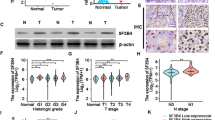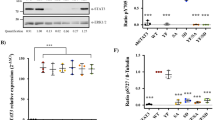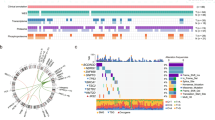Abstract
A subset of papillary renal cell carcinomas (RCC) is characterized by the expression of a TFE3 fusion protein, where the fusion partner can be any of the several proteins identified so far such as PSF (PTB associated splicing factor), NonO, PRCC, CLTC and ASPL. These proteins result from chromosomal translocations involving the TFE3 gene located on the X chromosome. Our present study documents the central role of PSF-TFE3 in oncogenic transformation. We show that the inhibition of PSF-TFE3 expression through siRNA or shRNA leads to impaired growth, proliferation, invasion potential and long-term survival of UOK-145 papillary renal carcinoma-derived cells, which endogenously express PSF-TFE3. The oncogenic potential of PSF-TFE3 became evident by stable expression of PSF-TFE3 in NIH-3T3 mouse fibroblast cells, which leads to the acquisition of anchorage-independent growth as revealed by soft agar assay. In addition, the expression of PSF-TFE3 in normal renal proximal tubular epithelial cells from where such tumors originate leads to dedifferentiation and loss of some key functional proteins, which may reflect an initial step in the multistep process of tumor development. This suggests that the expression of PSF-TFE3 in renal epithelial cells plays an important role in the initiation and maintenance of oncogenic phenotype in papillary RCC.
This is a preview of subscription content, access via your institution
Access options
Subscribe to this journal
Receive 50 print issues and online access
$259.00 per year
only $5.18 per issue
Buy this article
- Purchase on Springer Link
- Instant access to full article PDF
Prices may be subject to local taxes which are calculated during checkout





Similar content being viewed by others
References
Albini A, Iwamoto Y, Kleinman HK, Martin GR, Aaronson SA, Kozlowski JM et al. (1987). Cancer Res 47: 3239–3245.
Argani P, Antonescu CR, Illei PB, Lui MY, Timmons CF, Newbury R et al. (2001). Am J Pathol 159: 179–192.
Argani P, Lui MY, Couturier J, Bouvier R, Fournet JC, Ladanyi M . (2003). Oncogene 22: 5374–5378.
Bennicelli JL, Barr FG . (2002). Curr Opin Oncol 14: 412–419.
Bissell MJ, Radisky D . (2001). Nat Rev Cancer 1: 46–54.
Bodmer D, Van Den Hurk W, Van Groningen JJ, Eleveld MJ, Martens GJ, Weterman MA et al. (2002). Hum Mol Genet 11: 2489–2498.
Gao CF, Xie Q, Su YL, Koeman J, Khoo SK, Gustafson M et al. (2005). Proc Natl Acad Sci USA 102: 10528–10533.
Guo HF, Gong K, Zou SM, Zhang ZW, Liu XY, Na X et al. (2004). Zhonghua Wai Ke Za Zhi 42: 196–200.
Kolb RJ, Woost PG, Hopfer U . (2004). Hypertension 44: 352–359.
Kovacs G, Akhtar M, Beckwith BJ, Bugert P, Cooper CS, Delahunt B et al. (1997). J Pathol 183: 131–133.
Ladanyi M, Lui MY, Antonescu CR, Krause-Boehm A, Meindl A, Argani P et al. (2001). Oncogene 20: 48–57.
Le TH, Oliverio MI, Kim HS, Salzler H, Dash RC, Howell DN et al. (2004). Physiol Genom 18: 290–298.
Lindor NM, Dechet CB, Greene MH, Jenkins RB, Zincke MT, Weaver AL et al. (2001). Genet Test 5: 101–106.
Mathur M, Das S, Samuels HH . (2003). Oncogene 22: 5031–5044.
Morrissey C, Martinez A, Zatyka M, Agathanggelou A, Honorio S, Astuti D et al. (2001). Cancer Res 61: 7277–7281.
Murer H, Hernando N, Forster I, Biber J . (2000). Physiol Rev 80: 1373–1409.
Orosz DE, Woost PG, Kolb RJ, Finesilver MB, Jin W, Frisa PS et al. (2004). In vitro Cell Dev Biol Anim 40: 22–34.
Radisky D, Hagios C, Bissell MJ . (2001). Semin Cancer Biol 11: 87–95.
Sanders ME, Mick R, Tomaszewski JE, Barr FG . (2002). Am J Pathol 161: 997–1005.
Skalsky YM, Ajuh PM, Parker C, Lamond AI, Goodwin G, Cooper CS . (2001). Oncogene 20: 178–187.
Storkel S, Eble JN, Adlakha K, Amin M, Blute ML, Bostwick DG et al. (1997). Cancer 80: 987–989.
Weterman MA, van Groningen JJ, den Hartog A, Geurts van Kessel A . (2001a). Oncogene 20: 1414–1424.
Weterman MA, van Groningen JJ, Tertoolen L, van Kessel AG . (2001b). Proc Natl Acad Sci USA 98: 13808–13813.
Wiesener MS, Munchenhagen PM, Berger I, Morgan NV, Roigas J, Schwiertz A et al. (2001). Cancer Res 61: 5215–5222.
Yang JC, Haworth L, Sherry RM, Hwu P, Schwartzentruber DJ, Topalian SL et al. (2003). N Engl J Med 349: 427–434.
Acknowledgements
We would like to thank Colin S Cooper for the UOK-145 cell line and Kathryn Calame for TFE3 antibody. Plasmid expressing GFP-TFE3 was kindly provided by Graham Goodwin and Matrigel by Hynda K Kleinman at NIDCR, NIH. At the NYUSOM we would like to thank Zheng-Sheng Ye for the pLPC plasmid, Dan Littman for SVpsi-A-MLV, an amphotropic packaging vector and Dr Claudio Basilico for NIH-3T3 cells. This research was supported by NIH Grant AR02083 to Mukul Mathur, DK16636 to HHS and a grant from the EIF foundation to HHS.
Author information
Authors and Affiliations
Corresponding author
Rights and permissions
About this article
Cite this article
Mathur, M., Samuels, H. Role of PSF-TFE3 oncoprotein in the development of papillary renal cell carcinomas. Oncogene 26, 277–283 (2007). https://doi.org/10.1038/sj.onc.1209783
Received:
Revised:
Accepted:
Published:
Issue Date:
DOI: https://doi.org/10.1038/sj.onc.1209783
Keywords
This article is cited by
-
Dissolution of oncofusion transcription factor condensates for cancer therapy
Nature Chemical Biology (2023)



